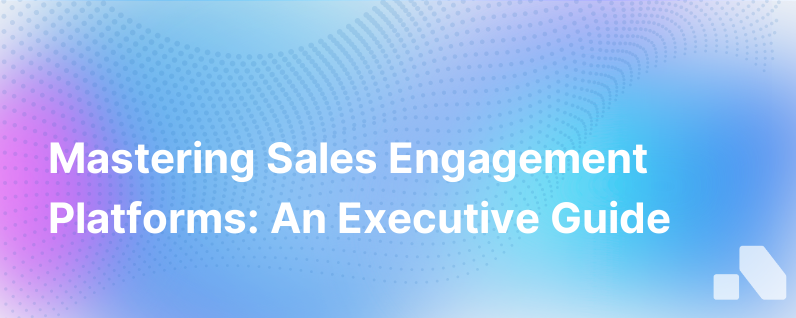
Sales engagement platforms (SEPs) have emerged as a cornerstone in the modern sales stack, offering a sophisticated blend of automation, intelligence, and integration to dramatically transform the sales process. In this definitive guide, we’ll explore the what, why, and how of SEPs, offering insights to B2B sales leaders on leveraging these powerful platforms to enhance productivity, improve customer relationships, and ultimately, drive revenue.
What is a Sales Engagement Platform?
At its core, a sales engagement platform is a suite of tools designed to streamline and improve the interactions between sales teams and potential customers. These platforms are engineered to encompass the entirety of the sales process, from lead generation to deal closure, serving as a centralized hub for outbound communications, campaign management, content sharing, performance analytics, and more.
SEPs often include features such as:
- Email automation and tracking: Enables scheduled email campaigns with features like open and click tracking.
- Integrated dialers: Keeps phone calls within the platform for easy note-taking and call recording.
- Sales cadence/workflow builders: Allows for the creation of multi-step, multi-channel outreach sequences.
- Content sharing and management: Provides a repository for sales collateral that can be easily accessed and shared with prospects.
- Analytics and reporting: Offers insights into what strategies are working and where there's room for improvement.
Why Are Sales Engagement Platforms Important?
SEPs revolutionize the sales process by addressing several critical areas:
1. Efficiency: Automation of routine tasks such as email follow-ups and scheduling meetings, saving reps precious time and letting them focus on high-value activities like relationship-building and strategic planning.
2. Personalization at Scale: SEPs offer the ability to personalize outreach on a mass scale. This ensures that communication feels tailored to each recipient, despite being part of an automated sequence.
3. Consistency: By standardizing communication workflows, SEPs ensure a consistent approach to customer engagement, important for maintaining brand voice and experience.
4. Data-Driven Decisions: By integrating with CRMs and providing deep analytics, SEPs allow teams to make informed decisions based on real-time data. Knowing what types of outreach work best can help refine and improve future campaigns.
5. Collaboration: By serving as a shared platform for all sales communications, SEPs promote transparency and collaboration among team members, which is essential to building a cohesive sales strategy.
6. Integration: SEPs often integrate with a range of other tools, including CRMs, marketing automation platforms, and data enrichment services. This creates an interconnected ecosystem that further streamlines the sales process.
Choosing the Right Sales Engagement Platform
When selecting an SEP for your organization, consider the following:
- Integrate with Existing Tools: Ensure the platform seamlessly integrates with your CRM and other tools to create a unified workspace.
- Scalability: As your team grows, you’ll want an SEP that can grow with you.
- Usability: A platform that is easy to understand and use is important for adoption across your sales team.
- Customization: Look for platforms that allow you to tailor workflows and content to align with your sales process.
- Vendor Support: Evaluate the level of customer support provided. Reliable support can be crucial to resolving issues quickly.
Implementing a Sales Engagement Platform
Successful implementation of an SEP entails a strategic approach:
1. Alignment with Sales Process: The SEP should complement and enhance your existing sales processes, not force you to adapt to it. 2. Team Training: Comprehensive training ensures your sales team can leverage the full potential of the platform. 3. Data Hygiene: SEPs are most effective with clean and current data; ensure your customer records are up-to-date before integrating. 4. Performance Metrics: Establish metrics to measure the success of your SEP and ensure alignment with overall sales goals. 5. Continuous Optimization: Use the insights gained from SEP analytics to evolve and enhance your sales strategies consistently.
Industry Leaders in Sales Engagement
Several SEPs have distinguished themselves in the market:
- Outreach: Known for its robust feature set and seamless integration with multiple CRMs, Outreach is a favorite among enterprise sales teams.
- Salesloft: Offers a user-friendly interface and strong analytics capabilities, making it popular across a variety of business sizes.
- Yesware: Provides powerful email tracking and tools geared toward individual sales reps and teams.
- Groove: Appeals to organizations looking for tailored solutions with a strong focus on relationship-building.
How Sales Engagement Platforms Fit Into The Bigger Picture
Sales engagement platforms are not standalone solutions; they are part of a holistic approach to sales technology. Integrating an SEP with customer relationship management (CRM) systems, business intelligence tools, and marketing automation platforms creates a comprehensive tech stack that captures every aspect of the buyer’s journey.
With robust analytics, every email sent, call made, and content piece shared contribute to a growing database of knowledge that informs both current and future sales strategies, ensuring that your approaches are optimized for the highest possible success rates.
Lean into the Future of Sales with Aomni
In conclusion, as an AI-driven solution itself, Aomni appreciates the transformative impact of advanced technology on sales. SEPs are a testament to how strategic automation, insightful data, and seamless integration can reshape the sales landscape, enabling teams to engage more meaningfully with prospects at scale, driving growth, and customer satisfaction.
While this guide has equipped you with the foundational knowledge required to understand and begin leveraging sales engagement platforms, the journey towards sales excellence is an ongoing path of learning and implementation. With platforms like Aomni, powering your B2B sales cycles becomes an exercise in strategic precision, where real-time insights and personalized content can be delivered effortlessly, ensuring your sales team is always steps ahead.